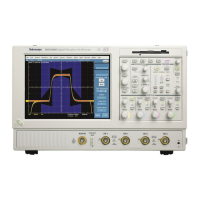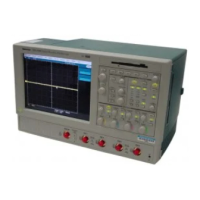TDS5000B Online Programmer Guide
-- 1 4 --
2. You can mix quotation marks within a string as long as you follow
the previous rule. For example, ”this is an ’acceptable’ string”.
3. You can include a quote character within a string by repeating the
quote. For example: ”here is a ”” mark”.
4. Strings can have upper or lower case characters.
5. If you use a GPIB network, you cannot terminate a quoted string
with the END message before the closing delimiter.
6. A carriage return or line feed embedded in a quoted string does not
terminate the string, but is treated as just another character in the
string.
7. The maximum length of a quoted string returned from a query is
1000 characters.
Here are some invalid strings:
H ”Invalid string argument’ (quotes are not of the same type)
H ”test<EOI>” (termination character is embedded in the string)
Block
Several instrument commands use a block argument form (see the fol-
lowing table).
Block Arguments
Symbol Meaning
<NZDig> A nonzero digit character in the range of 1–9
<Dig> A digit character, in the range of 0–9
<DChar> A character with the hexadecimal equivalent of 00
through FF (0 through 255 decimal)
<Block> A block of data bytes defined as:
<Block> ::=
{#<NZDig><Dig>[<Dig>...][<DChar>...]
|#0[<DChar>...]<terminator>}
<NZDig> specifies the number of <Dig> elements that follow. Taken
together, the <NZDig> and <Dig> elements form a decimal integer that
specifies how many <DChar> elements follow.

